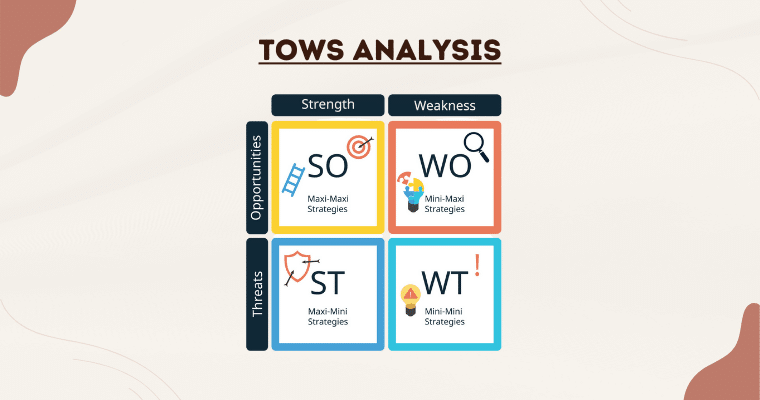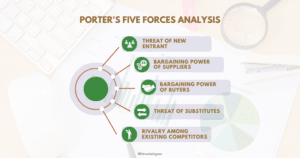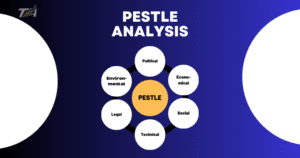Organizations seek to continuously monitor and adapt to internal and external environments in a rapidly changing business environment to sustain competitiveness. Here, the TOWS Matrix/ TOWS strategy is one of the strategic tools to analyze the situation. The SWOT framework, TOWS analysis, is concerned with strategies concerning turning threats and opportunities into action. The article will dwell on TOWS analysis, give examples together with templates, and talk about how to effectively implement this tool to support strategic planning.
What is TOWS Analysis?
The TOWS analysis method is an advanced form of SWOT analysis that helps in identifying factors affecting an organization. It also creates choices in strategy through the matching of internal strengths and weaknesses with external opportunities and threats. This technique is mainly applied in finding strategic alternatives that leverage the strengths and opportunities or reduce the weaknesses and threats.
How TOWS Differs from SWOT
Though SWOT and TOWS analysis are strategic planning tools, they differ in approach. SWOT analysis involves simply the detection of the internal and external factors of a firm, listing them, and noting them down. Whereas, TOWS analysis, on the other hand, takes the extra mile to spell out corresponding strategies born out of the interaction of these factors. TOWS was explicitly developed in pursuit of active strategies from the SWOT matrix, thus making it more dynamic in strategic management.
TOWS Analysis Template
A simple TOWS matrix (TOWS Analysis) consists of four quadrants as follows:
Strengths-Opportunities (SO): Build on strengths to exploit opportunities.
Strengths-Threats (ST): Use strengths to mitigate threats.
Weaknesses-Opportunities (WO): Conquer the weaknesses with major opportunities available.
Weaknesses-Threats (WT): Use strategies that minimize weaknesses to avoid threats.
Here is a basic template for a TOWS analysis:
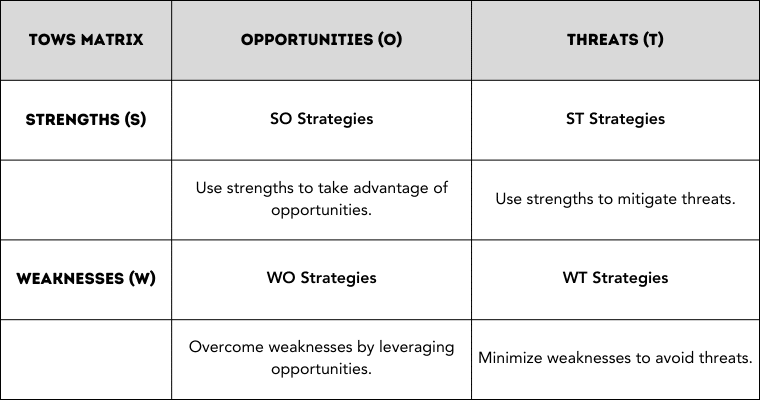
How to Conduct a TOWS Analysis?
- Identify the strengths: Identify the internal strengths, which can be such as its strong brand reputation, sufficient financial resources, or skilled manpower.
- Identify Weaknesses: Any internal weakness such as a lack of resources, unskilled or semiskilled people, and inefficient processes has to be identified.
- Identify Opportunities: The external opportunities may be sensed through market trends, changes in technology, or regulatory changes.
- Identify the Threats: Check for any threats from outside, such as competitive pressures, a falling economy, or a change in consumer behavior.
- Match Factors: Here, the TOWS matrix is used for matching the internal and external factors for building strategies that exploit the strengths and opportunities or minimize the weaknesses and threats.
TOWS Analysis Example:
Starbucks
For example, let’s develop a TOWS analysis of Starbucks:
Strength:
- A well-known brand
- Widespread presence throughout the world
- Superior goods
Weaknesses:
- Expensive costs in comparison to rivals
- Reliance on the American market
- Concerns with ethical sourcing
Opportunities:
- Growing consumer need for eco-friendly goods
- Growth within Emerging Markets
- Advancements in technology for mobile ordering
Threats:
- Intense competition
- Prices for coffee beans fluctuate.
- Recessions in the economy
TOWS Matrix for Starbucks
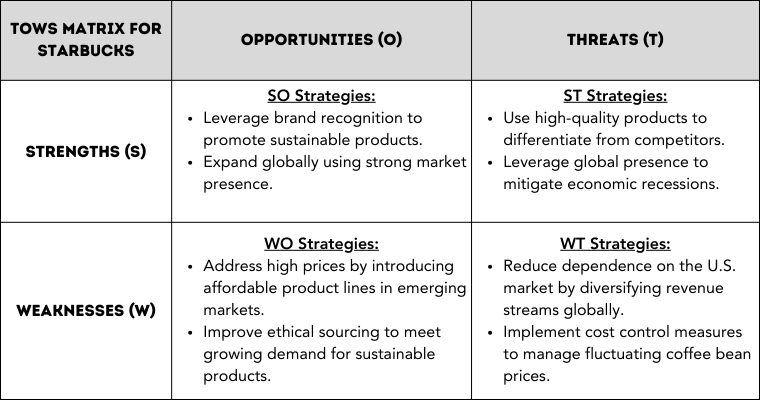
Implementing TOWS Analysis
The following steps or procedures are involved in conducting an effective TOWS analysis:
- Gather information: Collect all information related to internal strengths and weaknesses, and external opportunities and threats.
- Engage Stakeholders: Involving key stakeholders in the analysis to ensure a complete viewpoint.
- Design TOWS Matrix: Fill in the identified factors in the TOWS matrix.
- Develop Strategies: It involves the formulation of certain actionable strategies based on the identified interactions within the TOWS matrix.
- Implement Strategies: Derive an action plan to implement the strategies.
- Monitor and Review: Always keep monitoring the implementation of strategies in the plan. After that review how effective those strategies are.
SWOTTOWS Analysis: Integrating SWOT and TOWS
This can be done by integrating SWOT and TOWS analyses. First, one should conduct a SWOT analysis that identifies the internal and external factors, then proceed with the TOWS analysis in formulating strategic options. This will ensure that one has an understanding of the environment in which the business operates since the base for strategic planning is provided.
Other Related Useful Theories:
Conclusion
TOWS analysis is a highly effective tool for an organization to turn threats and opportunities into practical strategies. The model seeks to find a match between its internal strengths and weaknesses and the opportunities and threats in the external environment. So it comes up with strategic alternatives that will enable growth and reduce associated risks. Either way, by itself or together with SWOT, TOWS analysis gives a dynamic framework for strategic management.
Frequently Asked Questions (FAQs)
1. What is the difference between SWOT and TOWS analysis?
SWOT focuses on the identification of strengths, weaknesses, opportunities, and threats. Whereas, TOWS depends on the development of strategies given these factors.
2. How can TOWS analysis benefit my business?
TOWS analysis will help in making actionable strategies, wherein internal capabilities will align to the external factors avoiding misfits to obtain better strategic planning and competitive advantage.
3. Can TOWS analysis be used for any type of organization?
Of course, TOWS analysis can also be applied in various types of organizations: business, non-profit, or governmental.
4. What are the key components of a TOWS analysis matrix?
Crucially, of these factors, it involves identification of strengths, weaknesses, opportunities, and threats, and then developing SO, ST, WO, and WT strategies.
5. How often should a TOWS analysis be conducted?
The TOWS analysis should be performed often, more so in situations accompanied by major changes within the internal or external environments.
References
- Weihrich, H. (1982). The TOWS Matrix—A Tool for Situational Analysis. Long Range Planning, 15(2), 54-66.
- “Starbucks Corporation SWOT Analysis,” MarketLine, 2023.
- Society for Human Resource Management (SHRM). (2023). Strategic Planning for HR.
- Harvard Business Review. (2023). How to Conduct a SWOT Analysis.

